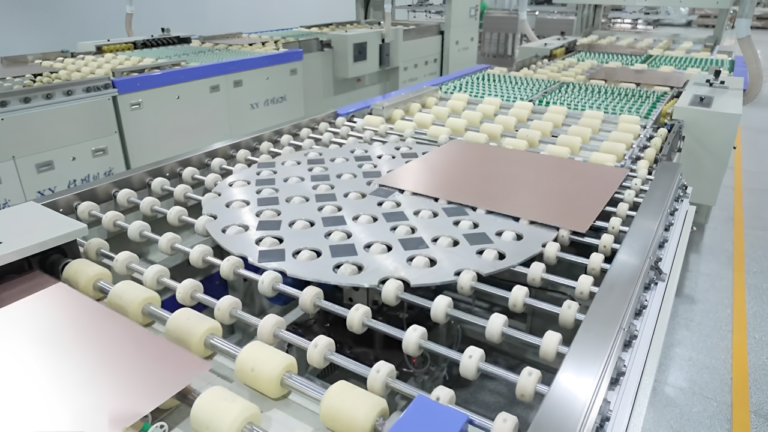More than 3000 square meters of warehouse, with a large stock
Light weight, small size, easy to air delivery
Injection molding department and machining department
24/7 one-on-one engineer service support
The PCB grinding machine in the circuit board equipment is a device used in the production process of the printed circuit board (PCB), which is mainly used for the surface leveling and smooth treatment of the circuit board. It is usually used to remove defects, oxides or other irregular impurities from the PCB surface to ensure that the board surface is smooth and provide appropriate surface quality for subsequent electroplating, coating or other processing processes.
Grinding Wheel / Abrasive Belt of PCB Grinding Machine: Used for surface grinding, removing oxidation, or polishing the PCB.
Conveyor System of PCB Grinding Machine: Transports PCBs through the machine for continuous processing.
Pressure Roller / Clamping System of PCB Grinding Machine: Secures the PCB in place to ensure stability during grinding.
Dust Collection System of PCB Grinding Machine: Captures debris and dust generated during grinding to maintain cleanliness.
Cooling System of PCB Grinding Machine: Prevents overheating of the PCB and grinding components.
Control Panel / Touchscreen Interface of PCB Grinding Machine: Allows operators to adjust settings and monitor the grinding process.
Motor & Drive System of PCB Grinding Machine: Powers the grinding mechanism for smooth and precise operation.
Thickness Calibration System of PCB Grinding Machine: Ensures consistent material removal and uniform board thickness.
Loading of PCB Grinding Machine: PCBs are placed on the conveyor system and fed into the machine.
Pre-Cleaning of PCB Grinding Machine: Some machines include a cleaning stage to remove dust or contaminants before grinding.
Surface Grinding of PCB Grinding Machine: The PCB passes through abrasive belts or grinding wheels that remove surface imperfections, oxidation, or excess copper.
Thickness Control of PCB Grinding Machine: Sensors or calibration systems ensure uniform material removal to achieve the desired board thickness.
Deburring (Optional) of PCB Grinding Machine: Some machines include a deburring process to smooth sharp edges after grinding.
Cleaning & Rinsing: The PCB undergoes high-pressure air or water cleaning to remove grinding residue.
Drying of PCB Grinding Machine: Hot air or vacuum drying ensures the PCB is completely dry before the next processing step.
Inspection & Unloading of PCB Grinding Machine: Quality checks are performed to ensure proper surface treatment before the PCB is unloaded.
Improper pressure settings, worn-out grinding wheel, or misaligned conveyor system.
Solution: Adjust pressure settings, replace worn-out grinding components, and realign the conveyor system.
Over-aggressive grinding, debris accumulation, or improper abrasive selection.
Solution: Reduce grinding pressure, clean the machine regularly, and use appropriate abrasive materials.
Inefficient dust collection system or clogged filters.
Solution: Clean or replace filters, ensure proper dust extraction system operation, and schedule regular maintenance.
High processing speed, improper material selection, or excessive pressure.
Solution: Adjust machine speed, use high-quality grinding materials, and reduce pressure to optimize tool lifespan.
High temperature, excessive pressure, or improper handling.
Solution: Use a cooling system, adjust pressure settings, and handle PCBs carefully to prevent bending.
Loose components, misalignment, or unbalanced grinding wheels.
Solution: Tighten machine parts, perform alignment checks, and balance or replace grinding wheels if necessary.
Residual contaminants, improper grinding depth, or excessive surface roughness.
Solution: Ensure thorough cleaning after grinding, calibrate depth settings, and optimize abrasive selection for better surface finish.

Grinding Precision & Consistency
Ensure the machine can achieve uniform material removal and precise thickness control. Look for automatic calibration systems to maintain accuracy.
Type of Grinding Mechanism
Abrasive belt grinding: Suitable for general surface finishing. Grinding wheel system: Provides more precise material removal. Wet vs. dry grinding: Wet grinding reduces heat and dust, improving PCB quality.
Processing Speed & Efficiency
Consider the machine’s processing speed to match production requirements. Look for adjustable speed settings for different PCB materials and thicknesses.
Material Compatibility
Ensure the machine supports various PCB substrates (e.g., FR4, CEM-3, metal-based PCBs).
Dust & Waste Management
A strong dust collection system prevents contamination and improves workplace safety. Machines with efficient cleaning mechanisms reduce downtime.
Automation & Control System
A user-friendly touchscreen interface or programmable settings enhance operational efficiency. Automated pressure adjustments ensure consistent results across different batches.
Cooling System
Prevents PCB warping and overheating, especially in high-speed grinding operations.
Durability & Maintenance
Check for high-quality grinding components and low maintenance requirements. Easy access to spare parts and technical support is crucial.
Safety Features
Emergency stop buttons, protective covers, and overheating protection enhance workplace safety.
Cost & ROI
Compare initial cost vs. long-term benefits like durability, efficiency, and energy consumption.
102, No.14-1 Jixiang 3rd Road, Yixin Community, Longgang District, Shenzhen, Guangdong Province, China.
+ 86 181 8840 4906
eternal02023@gmail.com
We’re professional manufacturer of PCB equipment and consumable. We can give you the best advice for your requirements.
© All Rights Reserved.
WhatsApp us

Eternal Tech is committed to becoming an expert in PCB conveying systems.